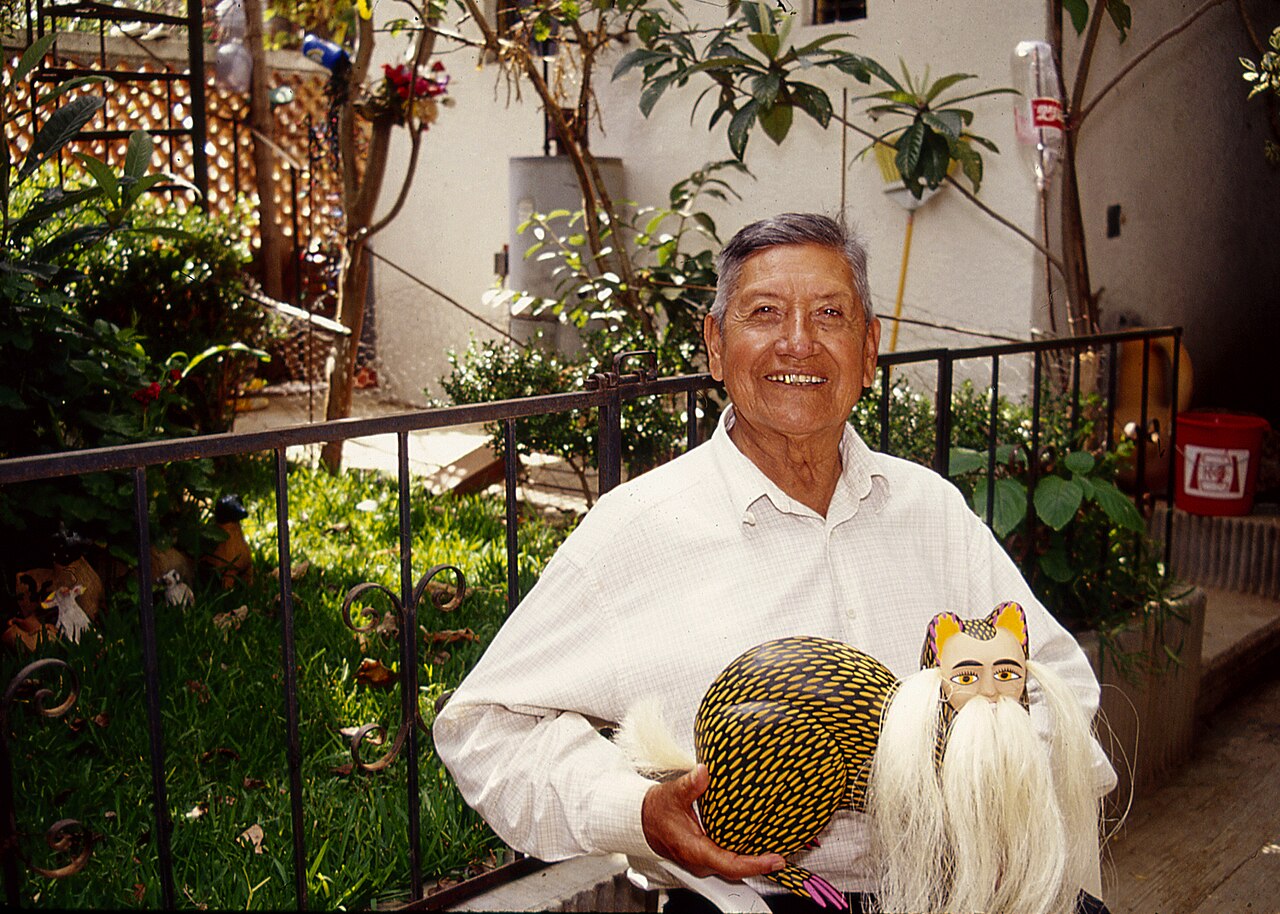
オアハカにおける手工芸品と民衆芸術
Handcrafts and folk art
in Oaxaca
Manuel
Jimenez with alebrije
☆オアハカの手工芸品と民芸品(Oaxaca handcrafts
and folk art)
は、メキシコにおける同種の重要な地域伝統の一つであり、その全体的な質と多様性によって際立っている。交易用の物品生産は、この州、特に中央谷間地域に
おいて重要な経済活動であった。この地域は先スペイン時代から、メキシコ中部と中央アメリカを結ぶ交易路上に位置していた。植民地時代にはスペイン人が新
たな原材料や技術、製品をもたらしたが、工業製品が台頭したことで20世紀初頭までに大半の手工芸品への需要は低下した。20世紀半ばに幹線道路が開通す
ると、この地域に観光客が訪れるようになり、伝統手工芸品にとって新たな市場が生まれた。今日、この州はメキシコで最も多くの職人を擁し、市場の嗜好の変
化に応えるべく、多様で進化し続ける製品を生み出している。
オアハカの手工芸品は、地域ごとに高度に専門化されている。代表的な工芸品には、サン・バルトロ・コヨテペクのニグロ陶器、サンタ・マリア・アツォンパの
緑釉陶器やその他の陶器、テオティトラン・デル・ヴァジェ及び周辺地域産の羊毛織物、トラコロラ・デ・マタモロス(及びその他多数の町や村)のメスカル、
そして新進の工芸品であるサン・アントニオ・アラソラとサン・マルティン・ティルカヘテ産のカラフルな木彫りの動物置物がある。生産の大半は中央谷間に集
中しているが、州内全域に職人が点在している。例えば、ヒウピル(伝統衣装)で知られるチナンタ地域、伝統衣装や金貨を用いた宝飾品で知られるテワント
ペック地域、州内のミステク地域で生産されるヤシの葉を編んだ工芸品などである。
| Oaxaca handcrafts
and folk art is one of Mexico's important regional traditions of its
kind, distinguished by both its overall quality and variety. Producing
goods for trade has been an important economic activity in the state,
especially in the Central Valleys region since the pre-Hispanic era
which the area laid on the trade route between central Mexico and
Central America. In the colonial period, the Spanish introduced new raw
materials, new techniques and products but the rise of industrially
produced products lowered the demand for most handcrafts by the early
20th century. The introduction of highways in the middle part of the
century brought tourism to the region and with it a new market for
traditional handcrafts. Today, the state boasts the largest number of
working artisans in Mexico, producing a wide range of products that
continue to grow and evolve to meet changing tastes in the market. Oaxacan handcrafts are also highly specialized by community. Notable wares include the barro negro pottery of San Bartolo Coyotepec, the green glazed and other pottery of Santa María Atzompa, the wool textiles of Teotitlán del Valle and surrounding communities, the mezcal of Tlacolula de Matamoros (and numerous other towns and villages) and a newcomer, colorful animal figures carved from wood made in San Antonio Arrazola and San Martín Tilcajete. Most of the production is in the Central Valleys, but artisans can be found all over the state including the Chinantla area with its huipils, the Tehuantepec area with its traditional clothing and jewelry made of gold coins and palm frond woven goods from the Mixtec area of the state. |
オアハカの手工芸品と民芸品は、メキシコにおける同種の重要な地域伝統
の一つであり、その全体的な質と多様性によって際立っている。交易用の物品生産は、この州、特に中央谷間地域において重要な経済活動であった。この地域は
先スペイン時代から、メキシコ中部と中央アメリカを結ぶ交易路上に位置していた。植民地時代にはスペイン人が新たな原材料や技術、製品をもたらしたが、工
業製品が台頭したことで20世紀初頭までに大半の手工芸品への需要は低下した。20世紀半ばに幹線道路が開通すると、この地域に観光客が訪れるようにな
り、伝統手工芸品にとって新たな市場が生まれた。今日、この州はメキシコで最も多くの職人を擁し、市場の嗜好の変化に応えるべく、多様で進化し続ける製品
を生み出している。 オアハカの手工芸品は、地域ごとに高度に専門化されている。代表的な工芸品には、サン・バルトロ・コヨテペクのニグロ陶器、サンタ・マリア・アツォンパの 緑釉陶器やその他の陶器、テオティトラン・デル・ヴァジェ及び周辺地域産の羊毛織物、トラコロラ・デ・マタモロス(及びその他多数の町や村)のメスカル、 そして新進の工芸品であるサン・アントニオ・アラソラとサン・マルティン・ティルカヘテ産のカラフルな木彫りの動物置物がある。生産の大半は中央谷間に集 中しているが、州内全域に職人が点在している。例えば、ヒウピル(伝統衣装)で知られるチナンタ地域、伝統衣装や金貨を用いた宝飾品で知られるテワント ペック地域、州内のミステク地域で生産されるヤシの葉を編んだ工芸品などである。 |
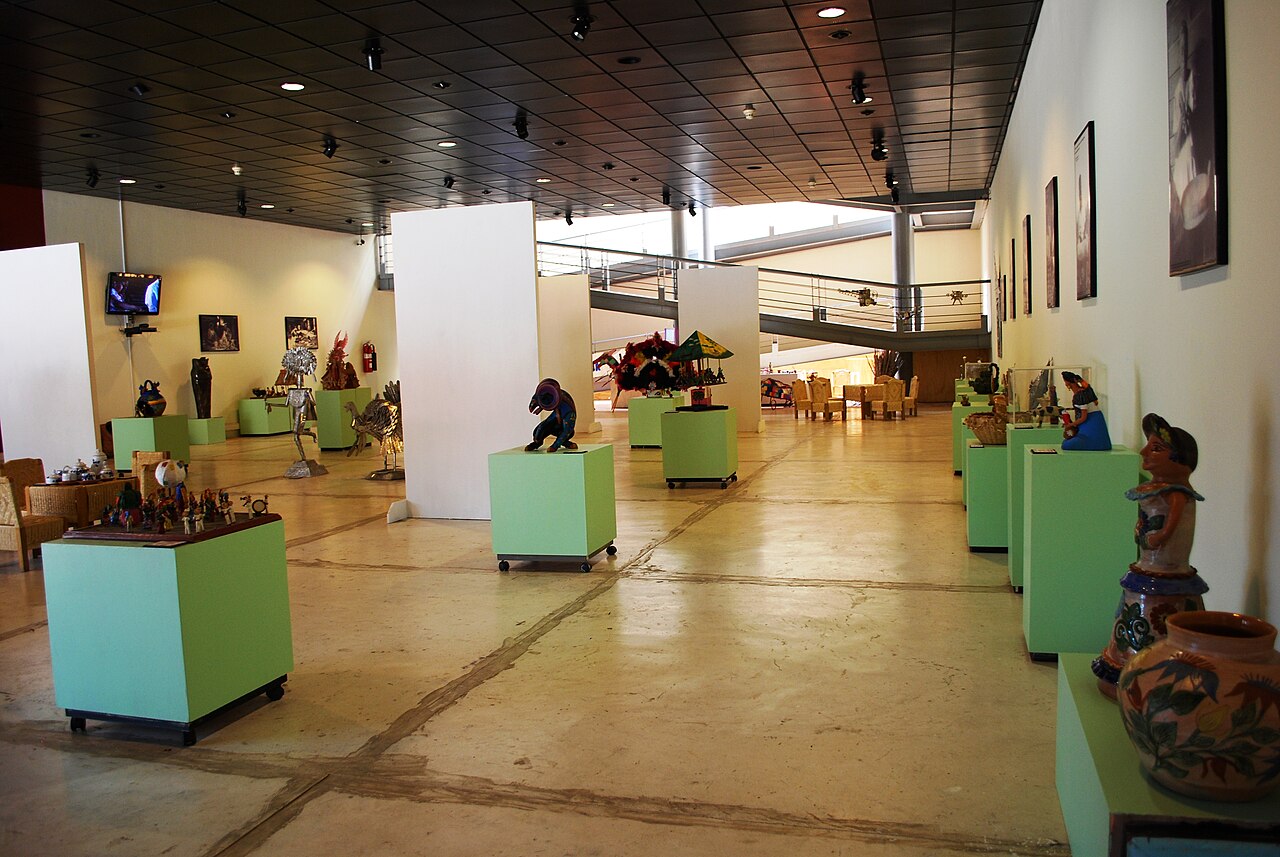 Exhibition hall from the Museo Estatal de Arte Popular de Oaxaca |
 オアハカ州立民俗美術館の展示ホール |
Status and distinguishing characteristics A "proto-turntable" and figure in progress from the Carlomagno Pedro Martínez workshop in San Bartolo Coyotepec The state of Oaxaca is one of the main and best-known producers of handcrafts (which includes certain kinds of processed foods) in Mexico. Its long tradition of production since the pre-Hispanic period along with an abundance of raw materials has allowed this tradition to stand out both in quality and the variety.[1][2][3] The most successful products are ceramics and textiles, followed by those made from wood and leather.[1] Other production includes wood carving, metal work, embroidery, leatherwork, fireworks, papel picado, stone work, furniture and more.[2][3][4][5] One distinguishing feature of Oaxaca handcrafts is specialization of production by community, which began in the pre-Hispanic period supported by a complex web of regional markets.[1][6] This tradition is maintained because of the state's mountainous terrain and poverty, which has inhibited the development of transportation infrastructure allowing communities to remain relatively autonomous and fractured politically and socially.[3] This tradition is one of the strongest in Mexico,[2] the number of artisan producers in Oaxaca was estimated at 451,837 artisans, equivalent to 12% of the state's total population (FONART, 2020).[7][8] The regional market system also remains in place to make handcrafts widely available in the state, especially in the Central Valleys region.[1] The strongest indigenous influences on Oaxacan handcrafts are Zapotec and Mixtec.[9] Local materials also have an effect on what is produced. In San Bartolo Coyotepec, the local clay turns a deep shiny black if the piece is burnished before firing. Traditional dyes for textiles include those made from the cochineal insect, which produces various shades of red and a marine snail found on the state's coastline for purple. Traditional fibers include cotton (brown and white), wool and maguey.[2][10] Production techniques are largely unchanged since the pre Hispanic and colonial periods, made in family workshops, with labor often divided by sex, age and social status.[3] A number of artisans and artisan families have gained reputation for fine products and the fine pieces can be found in museums in many parts of the world.[2] There is also innovation in the handcraft markets with artisans adapting designs to suit new markets and even the creation of new items, such as alebrijes.[4] |
現状と特徴 サン・バルトロ・コヨテペックのカロマグノ・ペドロ・マルティネス工房における「原始的なターンテーブル」と制作途中の像 オアハカ州はメキシコにおける手工芸品(特定の加工食品を含む)の主要かつ最も有名な生産地の一つである。先コロンブス期からの長い生産伝統と豊富な原材 料により、この伝統は品質と多様性の両面で際立っている。[1][2][3] 最も成功している製品は陶器と織物であり、次いで木工品と皮革製品が続く。[1] その他の生産品には木彫り、金属工芸、刺繍、革細工、花火、切り紙細工、石工、家具などがある。[2][3][4][5] オアハカ手工芸の特徴は、地域市場網に支えられた先コロンブス期から続く「地域別生産分業」だ。[1][6] この伝統が維持される背景には、山岳地形と貧困がある。交通インフラの発展を阻んだため、各地域は政治的・社会的に分断され、比較的自律した状態を保って いるのだ。[3] この伝統はメキシコでも最も強いもののひとつだ。[2] オアハカ州の工芸生産者数は451,837人と推定され、州総人口の12%に相当する(FONART、2020年)。[7][8] 地域市場システムも維持されており、特に中央谷間地域で手工芸品を広く流通させている。[1] オアハカ手工芸に最も強い影響を与えている先住民文化はサポテカ族とミシュテカ族である[9]。地元の素材も生産品に影響する。サン・バルトロ・コヨテ ペックでは、焼成前に磨くと地元の粘土は深い光沢のある黒色になる。織物の伝統染料には、コチニール虫から得られる様々な赤色と、州沿岸に生息する海産巻 貝から得られる紫色がある。伝統的な繊維には綿(茶色と白)、羊毛、マゲイが含まれる。[2][10] 生産技術は先コロンブス期や植民地時代からほぼ変わらず、家族工房で製作され、労働は性別、年齢、社会的地位によって分業されることが多い。[3] 多くの職人や職人の家族が優れた製品で名声を獲得しており、その精巧な作品は世界中の多くの博物館で見られる。[2] 手工芸品市場では革新も起きており、職人は新たな市場に合わせてデザインを適応させたり、アレブリヘスなどの新製品を生み出したりしている。[4] |
| Development 【動画映像:資料なし】 Elena Villaseñor Oviedo weaving a double-sided piece on a backstrap loom at the Feria Maestros del Arte 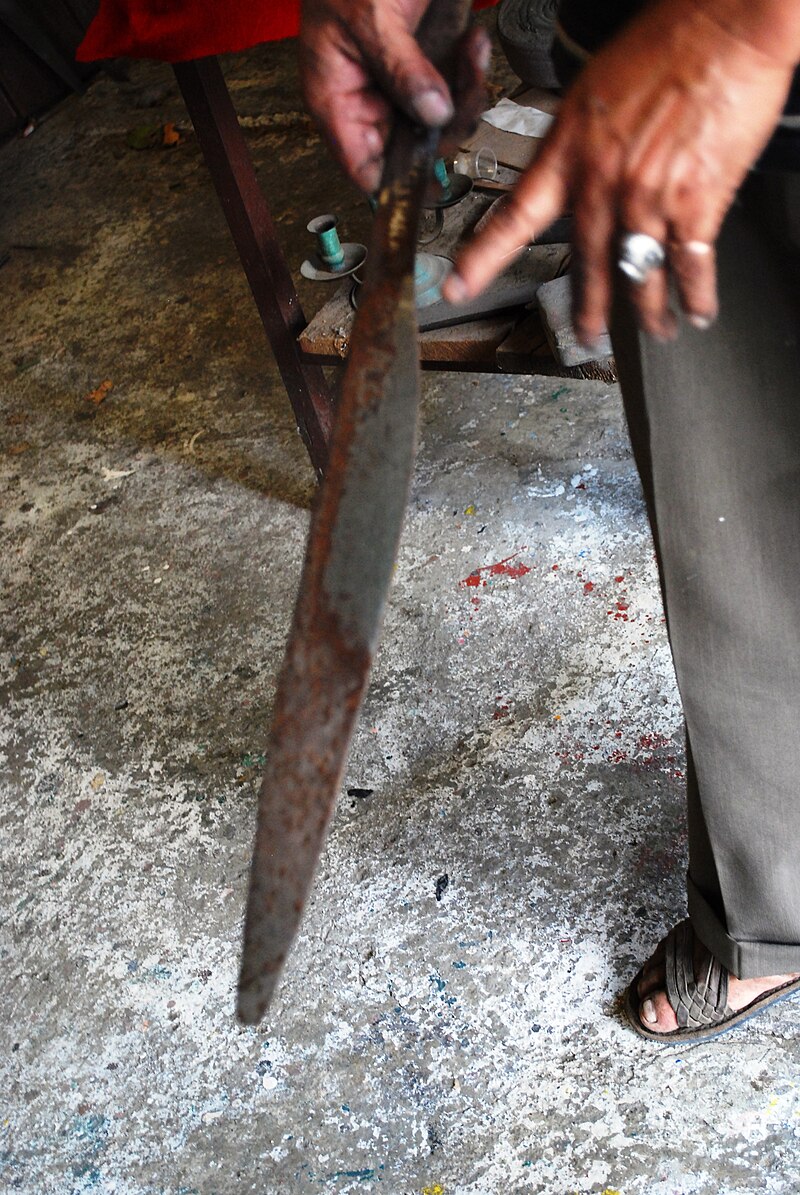 Blade in development at the Aguilar workshop in Ocotlán de Morelos The making of good for trade as well as local use was established in the region relatively early in the pre-Hispanic period because the state, especially the Central Valley, was on the trade route that connected central Mexico with Central America.[1] One example of this is the archeological site of El Palmillo, which was a major weaving center, with the weaving of various fibers established by the Classic Period. Then as now, production was centered in households with the households varying in the intensity and type of production.[11] One other common trade good was worked seashells, which the raw material coming from the Oaxacan coast despite the rough terrain, to be worked and then traded here.[12] This tradition of supplementing family income has remained to the present day. The main products have been textiles, ceramics, stone products, baskets and wood products although these have evolved and new products have been introduced.[1][3] The Spanish, at the beginning of the colonial period, introduced new raw materials, new products and new techniques to diversify the products the region's artisans produced. In the pre-Hispanic period, the main fibers were cotton and ixtle (made from maguey leaves), and the main weaving mechanism was the backstrap loom. The Spanish introduced wool and silk, along with new dyes/colors as well as the pedal loom, which allows faster weaving and the creation of larger pieces. Today Oaxacan weavers produce rugs, handkerchiefs, carrying bags, ponchos, various articles of clothing and more. These changes did not eliminate the older methods. The backstrap loom in still in use, as are dyes made from local plants, animals and minerals such as cochineal, an insect which is used to create red and tishinda, a marine snail used to create purple. The Spanish also introduced glazed ceramics, the filigree method of making gold and silver jewelry and the working of new metals, especially tin and iron.[1] By the 20th century, industrialization had chipped away at the production of handcrafts, especially for local use.[3] For example, by 1965 in San Miguel del Valle, only a few old men still weaved the local wood[clarification needed], using natural dyes because the demand was so low. However, in the 1960s and 1970s, the construction of modern roadways, especially the Pan American Highway, allowed the development of a tourist industry, catering to those looking to explore traditional Mexico as well as the coastline. The modern Oaxacan handcraft industry took off, with its initial market being tourists. This led to an interest in traditional methods with the numbers of artisans multiplying, especially in textiles and ceramics from the 1960s to the late 1980s. By the end of this period, a number of communities’ economies had changed from agricultural to those based on one particular handcraft.[6] The 20th century also saw some changes in technique, especially the use of synthetic dyes and paints and commercial thread, as well as lead-free glazes, but these have not completely replaced more traditional production.[1][6][13] 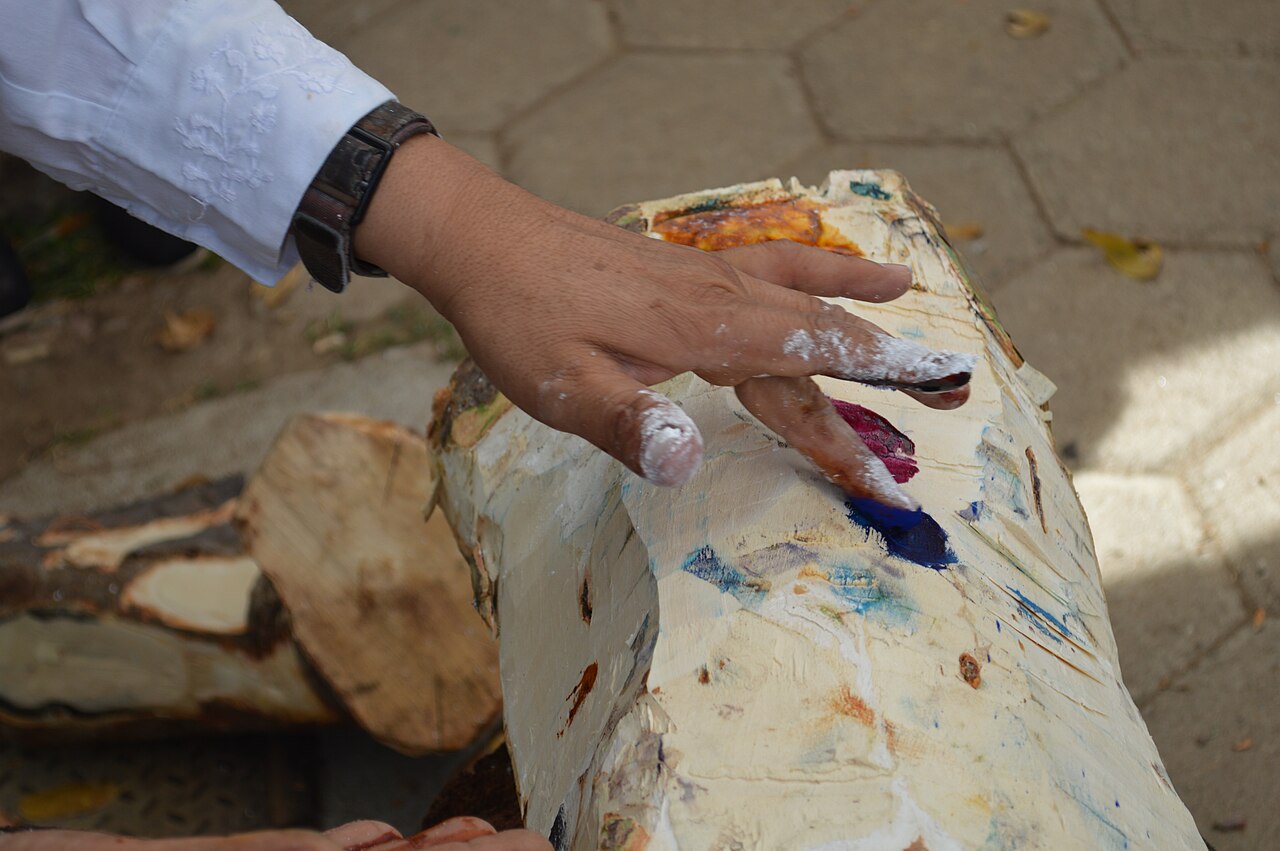 Jacobo Angeles demonstrates the making of paints with natural pigments in his workshop in San Martín Tilcajete Today, Oaxacan handcrafts are heavily dependent on the tourist trade, including collectors who come to the area especially for handcrafts. This success has also translated into an increase in exports of products to various parts of the world, especially to the United States.[3][14] The continued development of Oaxacan crafts is supported by both government and private entities. One method of doing this is to encourage younger generations to become craftsmen, with money for equipment and avenues to promote their merchandise such as contests.[15] These efforts also include those outside of Mexico, such as a government-run outlet in Pasadena, California, financing for export by Bancomext and sales by groups such as the Friends of Oaxacan Folk Art.[6][16][17] Handcraft traditions continue to evolve in the state, generally to cater to tourist and foreign tastes and include the creation of new products such as alebrijes.[1][6] The Centro de Diseño Oaxaca has worked to join artisans and contemporary designers to create new products based on traditional techniques and to document the development of handcrafts and folk art in the state.[18][19] The relationship of crafts to tourism has promoted the opening of a number of museums, generally in the Central Valleys area, to promote and education about the products. These include the Oaxaca Textile Museum (Museo Textile de Oaxaca) founded by the Alfredo Harp Foundation and has a permanent collection of over 1,000 pieces, including some that date from the 17th century.[10] Another example is the state run Museo Estatal de Arte Popular de Oaxaca, which mostly focuses on the barro negro pottery produced in San Bartolo Coyotepec, but contains representative example of all major crafts traditions in the state.[20] |
開発 【動画映像:資料なし】 フェリア・マエストロス・デル・アルテにて、エレーナ・ビジャセニョール・オビエドが腰機で両面織物を織っている様子  オコトラン・デ・モレロスにあるアギラール工房で開発中の刃物 この地域では、先コロンブス期に比較的早くから、貿易用と地元用の両方の製品作りが確立されていた。州、特に中央谷間は、メキシコ中部と中央アメリカを結 ぶ交易路上に位置していたためである。[1] その一例がエル・パルミージョ遺跡である。ここは主要な織物生産地であり、古典期までに様々な繊維の織物が確立されていた。当時も現在と同様に、生産は家 計単位で行われ、生産の規模や種類は家計によって異なっていた。[11] もう一つの一般的な交易品は加工された貝殻であった。原料は険しい地形にもかかわらずオアハカ州沿岸から運ばれ、ここで加工された後、取引されていた。 [12] この家計補助の伝統は現代まで続いている。主な製品は織物、陶器、石製品、籠、木製品だが、これらは進化し新製品も登場している。[1][3] スペイン人は植民地時代初期、新たな原料・製品・技術を導入し、地域の工芸品多様化を図った。先スペイン時代、主要な繊維は綿とイシュトレ(リュウゼツラ ンの葉から作られる)であり、主な織り機は腰機であった。スペイン人は羊毛と絹、新たな染料・色、そしてより速い織りと大型作品の制作を可能にする足踏み 式織機を導入した。現在オアハカの織工たちは、絨毯、ハンカチ、手提げ袋、ポンチョ、様々な衣類などを生産している。これらの変化は古い手法を廃れさせな かった。腰機は今も使われ、コチニール(赤色を作る昆虫)やティシンダ(紫色を作る海産巻貝)など、地元の植物・動物・鉱物から作られた染料も同様であ る。スペイン人はまた、釉薬を施した陶器、金銀細工の細工法、そして錫や鉄といった新たな金属の加工技術も導入した。[1] 20世紀に入ると、工業化が手工芸品の生産、特に地元向けの生産を徐々に侵食していった。例えば1965年までにサン・ミゲル・デル・バジェでは、需要が 激減したため天然染料を用いた地元の木織物を織る老人はわずか数名しか残っていなかった。しかし1960~70年代、特にパンアメリカン・ハイウェイの建 設により近代道路網が整備されると、伝統的なメキシコや海岸線を探索する観光客向けの観光産業が発展した。現代のオアハカ手工芸産業は、観光客を初期市場 として急成長した。これにより伝統技法への関心が高まり、特に1960年代から1980年代後半にかけて、織物や陶器の職人数が急増した。この時代の終わ りまでに、多くの地域経済は農業中心から特定の手工芸品に依存する形態へと変化した[6]。20世紀には技術面でも変化が見られ、特に合成染料・塗料、工 業用糸、鉛フリー釉薬の使用が増えたが、これらは伝統的な生産方法を完全に置き換えるには至っていない[1][6][13]。  ハコボ・アンヘレスはサン・マルティン・ティルカヘテの工房で天然顔料を用いた絵具の製造を実演している 今日、オアハカの手工芸品は観光業に大きく依存している。特に手工芸品を求めて訪れる収集家も含まれる。この成功は世界各地域、特にアメリカ合衆国への製 品輸出増加にもつながった[3][14]。オアハカ工芸の継続的発展は政府と民間団体の双方によって支えられている。その方法の一つは、若い世代が職人に なるよう奨励することだ。設備資金の提供や、コンテストなど商品宣伝の機会を設けている。[15] こうした取り組みはメキシコ国外にも及んでおり、カリフォルニア州パサデナにある政府運営の直売所、バンコメストによる輸出資金援助、オアハカ民芸品友の 会などの団体による販売活動などが挙げられる。[6][16][17] 手工芸の伝統は州内で進化を続けており、主に観光客や外国人の嗜好に応える形で、アレブリヘスなどの新製品も生まれている。[1][6] オアハカデザインセンターは、伝統技法に基づく新製品開発のため職人と現代デザイナーの連携を図り、州内における手工芸・民俗芸術の発展を記録する活動を 行っている。[18] [19] 工芸と観光の関係は、製品のプロモーションと教育を目的とした博物館の開設を促進してきた。これらは主に中央谷間地域に集中している。アルフレド・ハープ 財団が設立したオアハカ織物博物館(Museo Textile de Oaxaca)は、17世紀に遡る作品を含む1,000点以上の常設コレクションを有する。[10] もう一つの例は州立のオアハカ州立民俗芸術博物館(Museo Estatal de Arte Popular de Oaxaca)だ。主にサン・バルトロ・コヨテペックで生産されるバロ・ニグロ陶器に焦点を当てているが、州内の主要な工芸伝統の代表的な作品も収蔵して いる。[20] |
Challenges Young artisan adding fine detail to an alebrije Oaxacan artisans are noted for the quality of their work and business success; however, the industry still faces challenges.[4] There is little to no local demand for products because commercially made equivalents are cheaper and often easier to use. This means that artisans are almost completely dependent on tourism to keep traditions alive.[3] The success of Oaxacan crafts has put strains on the availability of raw materials. One example of this is the over-exploitation of copal trees, whose soft wood is preferred by alebrije carvers.[3][4] Another challenge is the introduction of cheaper imitations of products, generally from China. To date, few Mexican handcraft products have been eligible for certification guaranteeing authenticity.[3] Although the promotion of handcrafts and folk art is a priority in the social and economic development of the state, there is still a lack of government support, often due to bureaucracy.[3] Crafts that have a history in a town that dates back at least to the colonial period is more likely to receive support from government entities. Alebrijes is one exception.[4] The dependency of crafts on the tourism trade means that disruption here has a disproportionate effect on the industry. The 2006 Oaxaca protests severely curtailed tourism to Oaxaca and with it the sales of handcrafts, affecting one of the most vulnerable economic sectors of the state, with sales reduced during the uprising by up to 95% as shops in the historic center were forced to close. This meant that not only vendors in the city were affected but also handcraft producers throughout the Central Valleys who depend on sales in the capital. Political corruption and upheaval, such as the 2006 uprising, have had a negative effect on handcraft sales. The 2006 events hit the artisans hard because as small enterprises, they did not have the resources needed to adapt to rapidly changing conditions.[3] Since tourism centers on the city of Oaxaca, with relatively few venturing to the outlying areas where the products are made, many artisans are dependent on middlemen based in the city and often are in debt to them.[3][14] Wood carving and weaving artisans have formed cooperatives and other organizations to continue to promote their work. However, not all artisans have been able to do this.[4] Because of the difficulty in making a living, many artisans emigrate to the United States.[3] |
課題 アレブリヘに細工を施す若い職人 オアハカの職人は作品の質と事業の成功で知られるが、業界は依然として課題に直面している。[4] 商業製品の方が安価で扱いやすいため、地元での需要はほとんどない。つまり職人は伝統を守るため、ほぼ完全に観光業に依存しているのだ。[3] オアハカ工芸品の成功は原材料の供給に負担をかけている。その一例がコパル樹の乱伐だ。その柔らかい木材はアレブリヘ彫刻家に好まれる。[3][4] もう一つの課題は、主に中国からの安価な模造品の流入だ。現在まで、真正性を保証する認証を得られるメキシコ手工芸品はほとんどない。[3] 手工芸品や民俗芸術の振興は州の社会経済発展における優先課題だが、官僚主義が原因で政府支援が依然として不足している。[3] 少なくとも植民地時代に遡る歴史を持つ町の工芸品は、政府機関からの支援を受けやすい傾向にある。アレブリヘスはその例外だ。[4] 工芸品が観光業に依存していることは、観光業の混乱が業界に過大な影響を与えることを意味する。2006年のオアハカ抗議活動はオアハカへの観光客を激減 させ、それに伴い工芸品の販売も落ち込んだ。州内で最も脆弱な経済部門の一つである工芸品業界は、歴史地区の店舗が閉鎖を余儀なくされたため、抗議活動期 間中に売上が最大95%減少した。これは市内の販売業者だけでなく、首都での販売に依存する中央谷間の手工芸生産者全体にも影響を及ぼした。2006年の 反乱のような政治的腐敗や混乱は、手工芸品の販売に悪影響を与えたのである。2006年の事件が職人に深刻な打撃を与えたのは、小規模事業者である彼らが 急変する状況に適応する資源を持たなかったためだ[3]。観光がオアハカ市中心に集中し、製品が作られる周辺地域へ足を運ぶ観光客が比較的少ないため、多 くの職人は市内の仲介業者に依存し、しばしば彼らに借金を抱えている[3][14]。 木彫りや織物の職人たちは、自らの仕事を継続的に推進するため協同組合やその他の組織を結成している。しかし、全ての職人がこれを行えるわけではない。[4] 生計を立てるのが困難なため、多くの職人がアメリカ合衆国へ移住している。[3] |
| Towns of the Central Valleys Central Valleys 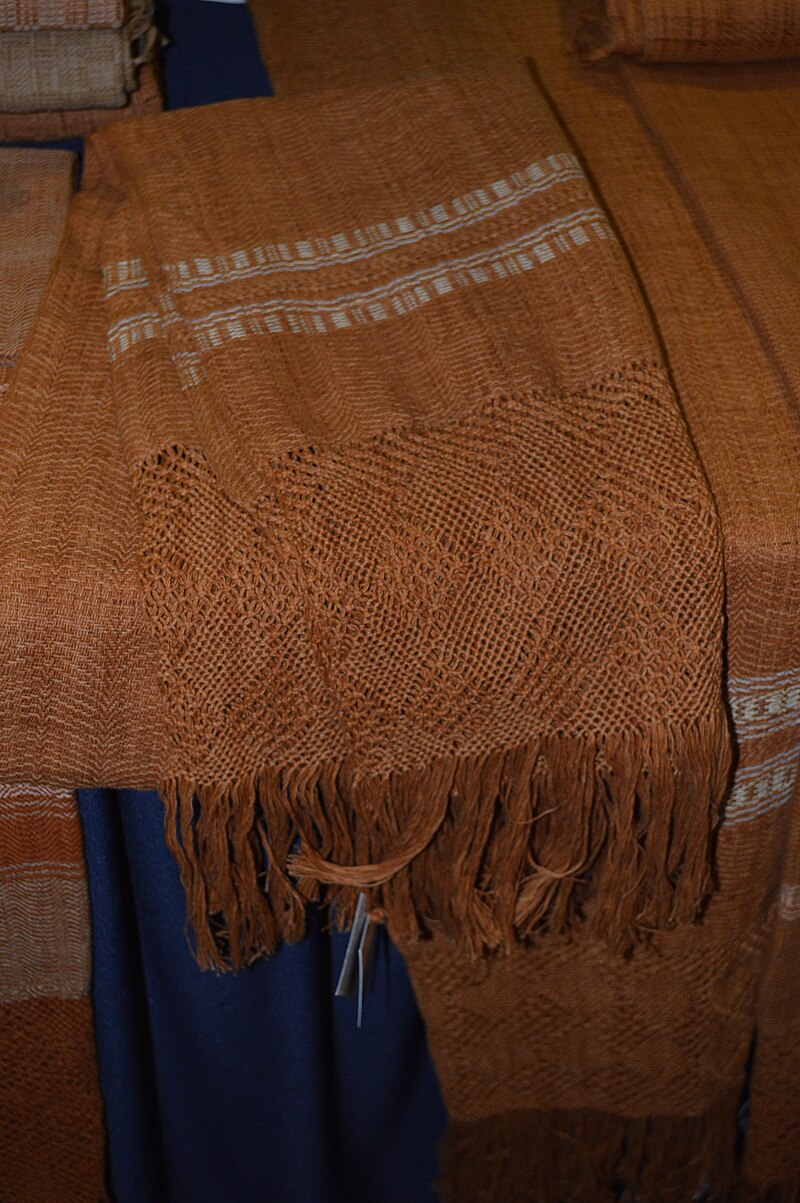 Rebozo from Santa Maria Tlahuitoltepec 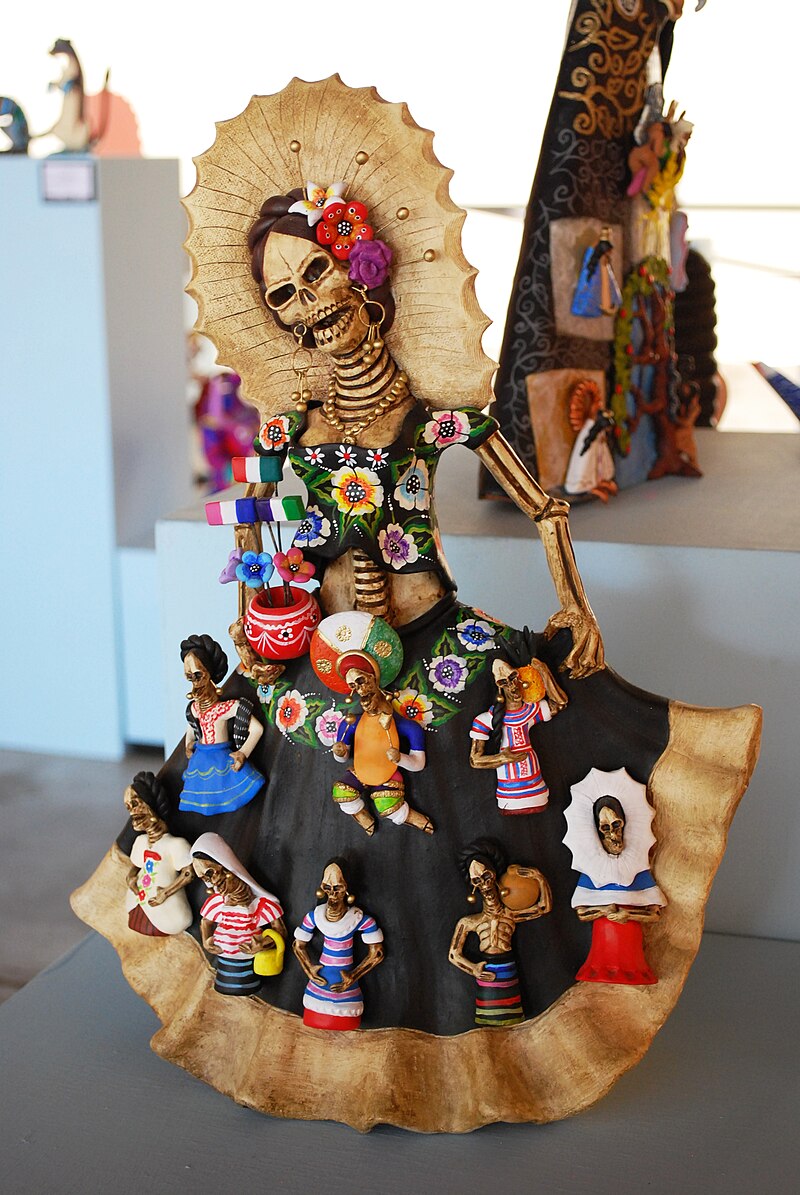 Skeletal ceramic piece by Leopoldo Garcia Aguilar of Ocotlan de Morelos Handcraft creation is mostly concentrated in the Central Valleys, the Zapotec region of the state.[6][9] This area has the highest degree of specialization and variety which includes ceramics, stiff fiber weaving (baskets), textiles of wool and cotton, stone work, wood work, the making of mezcal and leather work.[6] Most crafts-producing communities in the area specialize in one type or sub-type of handcraft and most are located in or near the city of Oaxaca.[2][3] Merchandise is manufactured for the tourist trade and sold through intermediaries mostly in the city of Oaxaca as relatively few tourists venture into the rural areas where the products are made.[6][14] Those who do venture outside the capital visit larger producers such as the weaving town of Teotitlan del Valle, and the alebrije carving centers of Arrazola and Tilcajete.[4] As the state center for handcraft distribution, there are numerous outlets including Mercado Benito Juarez, the Casa de las Artesanías de Oaxaca and the Jardín Labastida.[14] Other important regional crafts market in the Central Valleys are the market of Miahuatlán, with stands selling traditional clothing, foods and baskets; the tianguis in Ayoguezco, specializing in furniture and other wood products; and the small market in Etla, specializing in dairy products.[1] |
中央谷間の町々 中央谷間  サンタ・マリア・トラウィトルテペックのレボソ  オコトラン・デ・モレロスのレオポルド・ガルシア・アギラールによる骨格陶器 手工芸品の制作は主に中央谷間、州内のサポテカ地域に集中している。[6] [9] この地域は専門性と多様性が最も高く、陶器、硬質繊維編み(籠)、羊毛・綿織物、石細工、木工、メスカル製造、革細工などが含まれる。[6] この地域の工芸生産コミュニティのほとんどは、一つの工芸品またはその亜種に特化しており、その多くはオアハカ市またはその近郊に位置している。[2] [3] 製品は観光客向けに製造され、仲介業者を通じて主にオアハカ市で販売される。製品が作られる農村地域に足を運ぶ観光客は比較的少ないからだ。[6] [14] 州都外へ出かける観光客は、織物の町テオティトラン・デル・バジェやアレブリヘ彫刻の中心地アラソラ、ティルカヘテといった大規模生産地を訪れる。[4] 手工芸品流通の中心地として、ベニート・フアレス市場、オアハカ手工芸品館、ラバスティダ庭園など多数の販路が存在する。[14] 中央谷間地域におけるその他の重要な手工芸品市場としては、伝統衣装・食品・籠を扱う露店が並ぶミアワトラン市場、家具やその他の木製品を専門とするアヨ ゲスコのティアンギス、乳製品を専門とするエトラの小規模市場がある。[1] |
Teotitlan and surrounding communities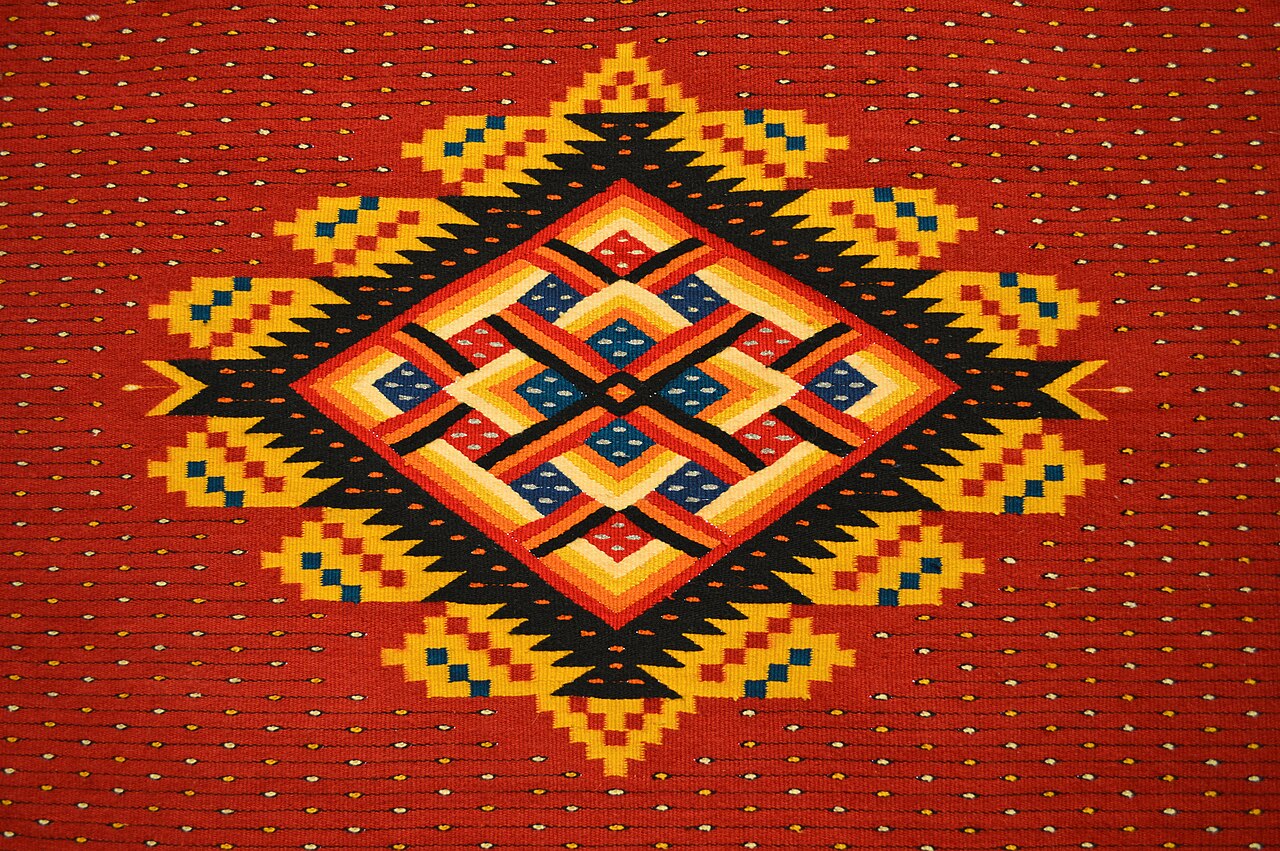 Rug woven by artist/artisan Arnulfo Mendoza in traditional Zapotec design at the Museo de los Pintores Oaxaqueños in the city of Oaxaca The weaving of wool was introduced to Oaxaca in the colonial period, but the specialization of rug making in Teotitlan del Valle and the surrounding communities dates to the development of weaving for the tourist trade.[6][21] These products are commercialized mainly in Mexico and in fine galleries and other venues in the United States.[4][21] The rugs are made in family workshops located in homes, with most workshops having three looms. Children learn the craft from a very young age, helping with the process with most having their own loom around age 12 to create small items such as bags and wall hangings. While the yarn used remains 100% wool, much of it is pre-dyed with commercial colorings.[6] The craft has adapted in various ways to international trade in the designs used in the works. Some are called “commercial” as they are popular in markets rather than traditional, although traditional Zapotec designs can still be readily found.[6][21] While most weavings are rugs, other products created here include blankets, pillows, director's chairs, handbags and wall hangings.[21] Teotitlan is the main producer and marketing center for these wool textiles, making it one of the most prosperous indigenous communities that depends on a handcraft.[21] Tourism to the town began in the 1970s, which gave it its status as an outlet for the even smaller communities around it.[6] The town and surrounding communities still speak Zapotec and marketers have worked to project an image of a single Zapotec community (though the smaller communities tend to produce pieces that show variations). This marketing has led to a class system among the Zapotec in the area, with the middlemen in Teotitlan in tension with producers even before goods reach outside hands.[21] The smaller communities that produce for sale in Teotitlán del Valle include Santa Ana del Valle, San Miguel del Valle and Díaz Ordáz.[21] In these communities as many as half are dedicated full-time to rug weaving.[6] |
テオティトランとその周辺地域 オアハカ市にあるオアハカ画家博物館に展示されている、芸術家/職人アルヌルフォ・メンドーサによる伝統的なサポテカ様式の絨毯 羊毛織物は植民地時代にオアハカに導入されたが、テオティトラン・デル・バジェとその周辺地域における絨毯製作の専門化は、観光業向けの織物産業の発展に 遡る。[6][21] これらの製品は主にメキシコ国内と、アメリカ合衆国の高級ギャラリーやその他の販売店で流通している。[4][21] 絨毯は家庭内の工房で製作され、ほとんどの工房には3台の織機がある。子供たちは幼い頃からこの技術を学び、作業を手伝いながら成長する。12歳頃には各 自が織機を持ち、バッグや壁掛けなどの小物を製作するようになる。使用される糸は100%羊毛だが、その多くは市販の染料で事前に染色されている。[6] 国際貿易に対応するため、作品のデザインは様々な形で変化してきた。市場で人気のあるものは「商業的」と称され、伝統的ではないが、伝統的なサポテカ族の デザインも依然として容易に見つかる。[6][21] 織物の大半はラグだが、毛布、枕、ディレクターズチェア、ハンドバッグ、壁掛けなども生産される。[21] テオティトランはこれらの羊毛織物の主要生産地かつ流通拠点であり、手工芸に依存する先住民コミュニティの中でも最も繁栄している地域の一つだ。[21] 観光業は1970年代に始まり、周辺のさらに小さな集落の販路としての地位を確立した。[6] 町と周辺集落では今もサポテコ語が話され、販売業者は単一のサポテコ共同体というイメージを打ち出そうとしている(ただし小規模集落の製品には差異が見ら れる)。このマーケティングは地域内のサポテコ族に階級制度を生み出し、テオティトランの仲介業者は製品が外部に流通する前から生産者と対立している。 [21] テオティトラン・デル・バレ向けに生産する小規模コミュニティには、サンタ・アナ・デル・バレ、サン・ミゲル・デル・バレ、ディアス・オルダスが含まれる。[21] これらのコミュニティでは、人口の半分近くが絨毯織りに専念している。[6] |
Atzompa and San Bartolo Coyotepec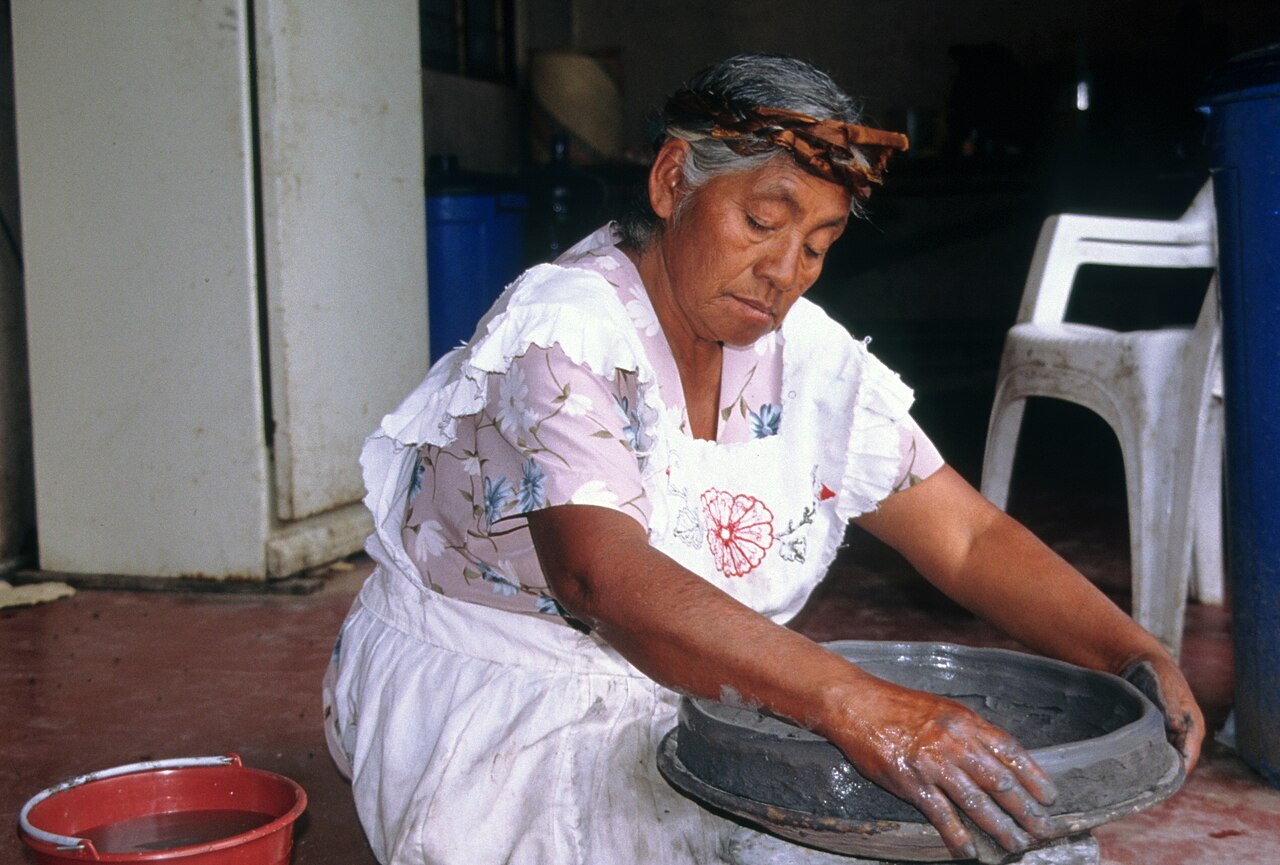 Dolores Porras working in Santa Maria Atzompa Pottery making can be found in many parts of the state, but the two best-known centers are San Bartolo Coyotepec and Santa Maria Atzompa.[14] Most of Oaxaca's pottery is made without potters’ wheels; instead it is produced with molds or formed by hand, sometimes using a kind of “proto-wheel”, which is a plate or shallow bowl place over an inverted bowl.[5] Ceramics are one of Oaxaca's best known handicrafts in Mexico. The most common glazed pieces include those with base colors of brown and white, shaped into vases, plates, cups and decorative pieces. For utilitarian pieces, molds are most commonly used. For very large pieces, such as cantaros and other storage containers, the molding is done in sections.[1] San Bartolo Coyotepec is the home of barro negro (black clay) pottery, the most recognized type from the state.[2] Barro negro is a non-glazed pottery, which gets its shine from burnishing, rubbing the dried piece before firing. It is almost exclusively made in the Coyotepec area. These pieces are also decorative and include lamps, large jars called cantaros, bells, masks, wall decorations and more.[1][2] To encourage visitors, the town hosts the Museo Estatal de Arte Popular de Oaxaca museum and has a Mercado de Artesanias (artisans' market).[22] Atzompa has been making pottery for at least 500 years. It is widely known for its traditional green glazed cookware and ornamental pieces. The glaze for the green pieces was originally lead-based but that was changed in the 1990s due to health concerns.[1][13] The green glazed ware is mostly formed into utilitarian items such as pots, cazuelas (casserole dishes), jars, bowls and more. More recently, artisans in the town have been experimenting with various other styles of pottery, mostly decorative times in a variety of styles. One of these is called “pastillaje” where very small and fine pieces of clay are formed and pressed onto the main surface of the piece to create decoration.[2] The town also has an outlet for its wares called the Casa de las Artesanias (House of the Artisans).[22] |
アツンパとサン・バルトロ・コヨテペック サンタ・マリア・アツンパで働くドロレス・ポラス 陶器作りは州内の多くの地域で見られるが、最も有名な二大産地はサン・バルトロ・コヨテペックとサンタ・マリア・アツォンパである[14]。オアハカ州の 陶器の大半はろくろを使わずに作られる。代わりに型を使って成形するか、手で形を作る。時には「原始的なろくろ」と呼ばれる技法を用いることもある。これ は逆さにした鉢の上に皿や浅い鉢を載せる方法だ。陶器はメキシコ国内でもオアハカ州を代表する手工芸品の一つだ。最も一般的な釉薬を施した陶器には、茶色 や白を基調とした花瓶、皿、カップ、装飾品などがある。実用的な陶器には型が最もよく使われる。カンタロ(大型水瓶)やその他の貯蔵容器のような非常に大 きな陶器は、複数のパーツに分けて成形される。[1] サン・バルトロ・コヨテペックは、州内で最も有名な「バロ・ニグロ(黒陶)」の産地である。[2] バロ・ニグロは釉薬をかけない陶器で、焼成前に乾燥した作品を磨くことで光沢を得る。ほぼコヨテペック地域のみで生産される。これらの作品は装飾性も高 く、ランプ、カンタロスと呼ばれる大型壺、鈴、仮面、壁飾りなどが含まれる。[1][2] 観光客誘致のため、町にはオアハカ州立民俗芸術博物館が置かれ、手工芸品市場(メルカド・デ・アルテサニアス)も運営されている。[22] アツォンパでは少なくとも500年にわたり陶器が作られてきた。伝統的な緑釉の調理器具や装飾品で広く知られている。緑釉の釉薬は元々鉛を基にしていた が、健康上の懸念から1990年代に変更された。[1][13] 緑釉陶器は主に実用的な品、例えば鍋、カズエラ(キャセロール皿)、壺、鉢などに形作られる。近年では、町の職人たちが様々な陶芸様式、主に装飾的な作品 を試作している。その一つが「パスティジャヘ」と呼ばれる技法で、非常に小さく細かい粘土片を成形し、作品の表面に押し付けて装飾を施す。[2] また、この町には「カサ・デ・ラス・アルテサニアス(工芸品館)」と呼ばれる作品の販売店もある。[22] |
Arrazola and Tilcajete Manuel Jimenez with alebrije Today, wood in Oaxaca is worked into masks and furniture; there is no local market for wood carving, with all production done for sales to tourists and collectors.[1][4] By far the most popular wood carving is the making of fantastic animal figures called alebrijes. These are mostly made in the towns of San Antonio Arrazola and San Martin Tilcajete, with some notable work done in La Unión Tejalapan.[5][14][23] Many buyers of alebrijes assume the works have a longer history in Mexico than they do.[4] They were created in the 20th century, with the concept conceived by Mexico City cartonería maker Pedro Linares, who Oaxaca lore states emigrated from Arrazola to the capital.[1] The Oaxaca version of alebrijes differ not only by being smaller and carved from wood, but the figures generally are more recognizable as a single animal such as lions, jaguars, iguanas, dragons, dogs, snakes, rather than an amalgam of various animal parts. The reason for this is that there is a long Zapotec tradition of the carving of wooden figures.[23] The first to develop Oaxaca alebrijes was Manuel Jiménez Ramírez of Arrazola, who created them for over thirty years before his death, using soft copal wood which is still preferred. He then painted them in bright colors and with intricate designs.[5][23] He was followed by Santos Pinos and then the craft spread to others in the town. It was similar in San Martín Tilcajete, where a few pioneering families started the trend there. The two towns originally began selling to tourists but eventually the pieces became collector's items that are now sold in shops and galleries in the US and other countries.[2] |
アラソラとティルカヘテ マヌエル・ヒメネスとアレブリヘ 今日、オアハカでは木材は仮面や家具に加工されている。木彫りの地元市場はなく、生産はすべて観光客や収集家への販売のために行われている。[1][4] これまでで最も人気のある木彫りは、アレブリヘと呼ばれる幻想的な動物の置物である。これらは主にサン・アントニオ・アラソラとサン・マルティン・ティル カヘテの町で製作されており、ラ・ウニオン・テハラパンでもいくつかの注目すべき作品が製作されている。[5][14] [23] アレブリヘスの購入者の多くは、この作品がメキシコでより長い歴史を持つと想定している。[4] それらは 20 世紀に、メキシコシティのカルトネリア職人ペドロ・リナレスによって考案されたコンセプトに基づいて制作された。オアハカの伝承によれば、彼はアラソラか ら首都に移住したとされる。[1] オアハカ版アレブリヘは、サイズが小さく木彫りであるだけでなく、ライオン、ジャガー、イグアナ、ドラゴン、犬、ヘビなど、単一の動物として認識しやすい 形をしている点で、様々な動物の部位を組み合わせたものとは異なる。その理由は、木彫りの像を作るというサポテカ族の長い伝統があるからだ。[23] オアハカ・アレブリヘスを最初に発展させたのはアラソラのマヌエル・ヒメネス・ラミレスである。彼は死の直前まで30年以上にわたり、現在も好まれる柔ら かいコパル材を用いて制作した。その後、鮮やかな色彩と複雑な文様で彩色した[5][23]。彼に続きサントス・ピノスが活動し、やがてこの工芸は町の他 の者たちへ広がった。サン・マルティン・ティルカヘテでも同様で、数家族の先駆者がこの潮流を生み出した。両町の工芸品は当初観光客向けだったが、やがて コレクターズアイテムとなり、現在では米国をはじめとする諸外国の店舗やギャラリーで販売されている。[2] |
| Santo Tomás Jalietza The town of Santo Tomás Jalieza specializes in cotton textiles, embroidered items and those woven with a backstrap loom such as blouses, sarapes (shawls), other traditional clothing and tablecloths.[9][22] It has been known for its backstrap loom works for at least 400 years, with most of its production in the colonial period sold locally, especially to communities in the Sierra de Villa Alta.[24] Since the early 20th century the producers in Jalieza have organized to produce and market their wares. The number of craftspeople in Jalieza has increased since the 1940s, and especially since the 1960s when the paving of the highway through the municipality brought tourism. The demand for the textiles by the 1970s was great enough that even men began to participate in what is traditionally women's work, but only inside the home and in private. However, the most successful textiles produced by the community are not the most traditional; instead they are pieces which have been modified to be more attractive to outside markets. Today the quantity and quality of pieces is regulated and promoted collectively, mostly through the Unión de Artesanos. It works to introduce new designs, create new markets and fix prices for merchandise. Then the market was completed in 1970, sales of textiles concentrated there. Many families have specialized in certain garments or other pieces.[24] |
サント・トマス・ハリエサ サント・トマス・ハリエサの町は、綿織物、刺繍製品、腰機で織られたブラウス、サラペ(ショール)、その他の伝統衣装やテーブルクロスなどの製造で知られている。[9][22] この町は少なくとも400年前から腰機織物の産地として知られており、植民地時代には生産物の大半が地元、特にビジャ・アルタ山地のコミュニティに販売されていた。[24] 20世紀初頭以降、ハリエサの生産者たちは組織化して製品の生産と販売を行うようになった。1940年代以降、特に1960年代に自治体を通る幹線道路が 舗装され観光業が発展すると、ハリエサの工芸家の数は増加した。1970年代には織物への需要が非常に高まり、男性までもが伝統的に女性の仕事であった織 物製作に参加するようになった。ただし、それは家庭内や私的な場に限られていた。しかし、この地域で最も成功した織物は最も伝統的なものではなく、外部市 場向けに改良された作品である。現在では、作品の量と質は主に「職人組合」を通じて共同で管理・促進されている。同組合は新デザインの導入、新たな市場の 開拓、商品の価格設定に取り組んでいる。1970年に市場が完成すると、織物の販売はそこに集中した。多くの家族が特定の衣類やその他の作品に特化してい る。[24] |
Basket making communities Craftswoman making banana leaf bun in Tavehua, Oaxaca. Not all crafts are internationally known or collected. One such is the weaving of baskets.[4] This craft is mostly practiced in very small communities in the Central Valleys region, where reeds grow abundantly along riverbanks. In addition to traditional baskets for carrying, the reeds are also fashioned into bird cages, lamps, candy dishes and screens/curtains.[1][2][5] Towns best known for this activity include Etla, Ocotlán de Morelos, Tlacolula, Santa Cruz Papalutla, Santa Ana del Valle, Villa Diaz Ordaz and San Miguel del Valle.[1][2][4] As these areas are not generally visited by tourists, the main outlets for baskets is the Centro de Abastos (wholesale food market) in the city of Oaxaca and the Sunday tianguis in Tlacolula.[4] This craft has not been promoted by governmental and other entities, as other crafts have been, and which is crucial to creating a wider market and to adapting the craft to modern tastes.[4] For this reason, and the fact that the local market is dwindling, the craft is in decline. One reason for the non-support of basket making is that the product is associated with rural areas rather than modern urban ones.[4] |
籠作りを行うコミュニティ オアハカ州タベワでバナナの葉のパンを作る女性職人。 全ての工芸品が国際的に知られ、収集されるわけではない。籠編みもその一つだ。[4] この工芸は主に中央渓谷地域の非常に小さなコミュニティで実践されている。そこでは葦が川岸に豊富に生えている。運搬用の伝統的な籠に加え、葦は鳥かご、 ランプ、菓子皿、スクリーンやカーテンにも加工される。[1][2][5] この工芸で特に有名な町には、エトラ、オコトラン・デ・モレロス、トラコロラ、サンタ・クルス・パパルトラ、サンタ・アナ・デル・バジェ、ビジャ・ディア ス・オルダス、サン・ミゲル・デル・バジェがある。[1][2] [4] これらの地域は一般的に観光客が訪れないため、籠の主な販路はオアハカ市のセントロ・デ・アバストス(卸売食品市場)とトラコロラのサンデー・ティアンギ スである。[4] この工芸品は他の工芸品のように政府やその他の団体によって推進されておらず、これが市場拡大や現代の嗜好への適応にとって決定的に重要である。[4] このため、また地元市場の縮小も相まって、この工芸は衰退している。籠細工が支援されない理由の一つは、製品が近代的な都市部ではなく農村地域と結びつけ られている点にある。[4] |
| Octolán de Morelos One exception to the specialization to one type of handcraft is the town of Octolán de Morelos, location south of the city of Oaxaca. The best known of the town's handcrafts is its pottery, the making of which is dominated by women.[25] The best known potters are the Aguilar family, dominated by sisters Josefina, Guillermina, Irene and Concepción who create fanciful multicolored figurines.[26] Ocotlán is noted for its production of hand-crafted knives and other blades.[5][22] Apolinar Aguilar Velasco is one of the best-known for making knives, swords, machetes and the like using the same techniques as those used in the 16th century. Aguilar began making blades when he was ten, taught by his father and uncle. He is now teaching the craft to the next generation.[27] |
オクトラン・デ・モレロス 手工芸品の一種に特化する傾向にある中で、オアハカ市の南に位置するオクトラン・デ・モレロス町は例外だ。この町で最も有名な手工芸品は陶器であり、その 製作は女性が中心となっている。[25] 最も有名な陶芸家はアギラール家であり、その中心は姉妹のホセフィーナ、ギジェルミナ、イレーネ、コンセプシオンである。彼女たちは幻想的な多色の置物を 制作する。[26] オクトランは手作りのナイフや刃物の生産で知られる。[5][22] アポリナール・アギラール・ベラスコは、16世紀と同じ技法でナイフ、剣、マチェテなどを製作する最も有名な職人の一人だ。アギラールは10歳の時に父と 叔父に教えられて刃物作りを始めた。今では次世代にこの技術を伝えている。[27] |
| Tlacolula de Matamoros Tlacolula is a small city east of the state capital. It is also known for various cottage industries especially the production of mezcal and wrought iron, but also for some textiles.[1][22] While mezcal is produced all over Oaxaca, Tlacolula is considered the center of production.[22] The beverage is made from various types of maguey plant such as tobalá, espadín and arroquense, either found wild or cultivated. The drink comes in a number of varieties, depending on the maguey used, the roasting and fermentation processes used and the aging. Although not all types use it, the “worm” in the bottle (really a larva) is associated with mezcal, not tequila. Mezcal is bottled straight or combined with flavorings to create cream style liquors.[1] Metal is also worked in the city, especially tin and iron, which were introduced by the Spanish. Tin in worked in mostly decorative items such as mirror frames and figures. Iron is worked into knives, daggers and other blades, machetes, tableware. Tlacolula is particularly noted for its production of wrought iron railings for buildings.[1][2] |
トラコロラ・デ・マタモロス トラコロラは州都の東にある小さな町だ。様々な家内工業、特にメスカルと錬鉄製品の生産で知られているが、織物も生産されている。[1][22] オアハカ州全域でメスカルは生産されているが、トラコロラはその中心地と見なされている。この酒はトバラ、エスパディン、アロケンセなど様々な種類のリュ ウゼツランから作られる。野生のものでも栽培されたものでもよい。使用するマゲイの種類、焙煎・発酵工程、熟成期間によって様々な種類が存在する。全ての 種類に当てはまるわけではないが、瓶の中の「虫」(実際には幼虫)はテキーラではなくメスカルの象徴である。メスカルはストレートで瓶詰めされるか、香料 を添加してクリームタイプの酒に加工される。[1] この街では金属加工も盛んで、特にスペイン人が持ち込んだ錫と鉄が用いられる。錫は主に鏡枠や置物などの装飾品に加工される。鉄はナイフ、短剣、その他の刃物、マチェーテ、食器などに加工される。トラコロラは特に建築用の錬鉄製手すりの生産で知られている。[1][2] |
| Other communities There is not much production of handcrafts in the city of Oaxaca itself. One exception to this is the working of sheet metal, which was established in the colonial period. The metal is mostly used for the making of candle holders and frames for windows and mirrors, along with fantasy figures and Christmas decorations.[2] The Xochimilco neighborhood of the city is known for the production of tablecloths, napkins and other such linens.[1] In Valle de Etla, one group of indigenous residents has taken to collecting old tires found on the highway and have begun converting them into handcrafts. The craft idea began with Esteban Perada, originally from Santiago Suchilquitongo. Originally he used them to support washers and retaining walls and car bumpers. Getting creative, he found a way to convert a tire into a toucan design to hang flowerpots, painting it bright colors. Others liked it and requested the item for their gardens. Since then he and others have created other figures such as parrots, squirrels and more, selling enough to supplement family income.[28] The town of San Juan Teitipac makes stone products, but two of their traditional product, mutates and molcajetes, have mostly been replaced by blenders and mixers.[3] |
その他の地域 オアハカ市自体では手工芸品の生産はあまり行われていない。例外は植民地時代に確立された板金加工だ。金属は主に燭台や窓枠・鏡枠、幻想的な置物やクリス マス装飾品の製作に使われる[2]。市内のソチミルコ地区はテーブルクロスやナプキンなどのリネン製品で知られている。[1] バジェ・デ・エトラでは、先住民グループが高速道路で見つけた廃タイヤを収集し、手工芸品へ転用する活動を始めた。この工芸の着想はサンティアゴ・スチル キトンゴ出身のエステバン・ペラーダが発案した。当初は洗濯物干しや擁壁、車のバンパーの支えとして使用していた。創意工夫を重ね、タイヤを鮮やかな色で 塗装し、花鉢を吊るすトゥーカンデザインの置物へ転用する方法を編み出した。この作品が評判となり、庭用に注文が殺到した。以来、彼と仲間たちはオウムや リスなど様々な造形物を制作し、家族の収入を補うほど販売している。[28] サン・フアン・テイティパック村では石製品を生産しているが、伝統的な製品であるムタテ(すり鉢)とモルカヘテ(すり器)は、ほとんどがブレンダーやミキサーに取って代わられている。[3] |
| Other parts of the state Huipils and blouses from Juchitán There are artisans in other parts of the state, although they are not as well known.[29] The state has a wide variety of textile traditions, with many communities having distinctive styles of dress and designs.[2] The Chinateca region in the north of the state is known for its unique huipil designs, made by the local Chinanteca and Mazatec peoples. Each town has its own variations and there are three types of huipils, those for everyday use, semi formal and formal.[30] Wrought iron and other metal work is found in the towns of Tlaxiaco in the west and Santa Catarina Juquila and Santiago Jamiltepec in the southwest of the state, generally practical items such as knives. The last is known for a local style of machete.[1][2][5] The Tehuantepec area produces an orange-colored pottery, which is highly resistant to breakage and generally used for tile, flowerpots and other heavy duty items. For decorative items, pastillaje is also use to add flowers and other foliage and may be fired a second time to affix coloring.[2] In Juchitan, wares include traditional local dress for men and women, clay dolls and masks, key chains, local candies and mezcal. Most Juchitan artisans must rely on intermediaries to get products to market. However, over fifty workshops in the Juchitan area has banded into a cooperative to promote their products, especially in May when the city hold its regional fair which attracts many visitors. The group also works to have products available at other events in the state, especially during the main tourist seasons.[29] Gold and silver jewelry is produced in the Tehuantepec area, both through the filigree method introduced by the Spanish as well as hand-hammered pieces. One local variety of jewelry is made from antique gold coins. Filigree and hammered pieces are also produced in Huajuapan de León, often reproductions of jewelry found in Monte Albán and other archeological sites.[1] The weaving of palm fronds is most commonly done in the tropical Mixtec region of the state in the west and includes hats, mats, flower vases and small purses. The most noted community for this work is Tlaxiaco, which also makes fine textiles and linens.[1][2] Most leatherwork can be found in Ejutla de Crespo and Jalatlaco, whose products are exported to other countries. Notable pieces include scabbards for machetes, saddles, wallets, belts, portfolios and more. The leather is made from the skins of local animals. Leather pieces such as belts and bags can be found embroidered with ixtle fiber, which is extracted from maguey leaves.[1][5] Coffee is grown and processed in the mountain areas near the coast, especially in the municipalities of Santa María Huatulco, Pluma Hidalgo, Candelaria Loxicha, San Miguel del Puerto, San Mateo Piñas, Santiago Xanica, and San Pedro Pochutla. This tradition dates from the 17th century when the coffee plant was introduced by English pirates, later developed in the 20th century by German immigrants.[1] |
州の他の地域 フイピルとブラウス(フチタン産) 州の他の地域にも職人はいるが、それほど知られていない。[29] この州には多様な織物の伝統があり、多くの地域で独特の服装様式やデザインが見られる。[2] 州北部のチナテカ地域は、地元のチナンテカ人民やマサテコ人民が作る独特のウイピルデザインで知られる。各町ごとに独自のバリエーションがあり、ウイピル には日常用、準公式用、公式用の3種類がある。[30] 鍛鉄やその他の金属工芸品は、州西部のトラシアコ、南西部のサンタ・カタリーナ・フキージャ、サンティアゴ・ハミルテペックの町で見られる。主にナイフなどの実用的な品である。後者は地元様式のマチェテで知られる。[1][2][5] テワントペック地域では、破損に極めて強いオレンジ色の陶器が生産される。主にタイル、植木鉢、その他の頑丈な物品に用いられる。装飾品には、花や葉を添 えるためにパスティジャヘ(粘土細工)も用いられ、着色を定着させるために二度焼きされることもある。[2] フチタンでは、男女の伝統的な民族衣装、粘土人形や仮面、キーホルダー、地元の菓子、メスカルなどが生産される。フチタンの工芸家の大半は、製品を市場に 出すために仲介業者に頼らざるを得ない。しかしフチタン地域では50以上の工房が協同組合を結成し、特に5月に開催される地域見本市(多くの観光客を集め る)で製品を宣伝している。この団体は州内の他のイベント、特に観光シーズン中のイベントでも製品を提供できるよう活動している。[29] テワントペック地域では金銀細工が生産されている。スペイン人が伝えたフィリグリー技法によるものと、手打ちの金銀細工がある。地元の特色ある細工品に は、古銭を再利用した金銀細工もある。フィリグリーや手打ちの金銀細工はワフアパン・デ・レオンでも生産されており、モンテ・アルバンや他の遺跡で出土し た宝飾品の複製品が多い。[1] ヤシの葉の編み物は、州西部の熱帯ミシュテカ地域で最も広く行われており、帽子、マット、花瓶、小銭入れなどが作られる。この工芸で最も有名な集落はトラシアコで、高級織物やリネン製品も生産している。[1][2] 革製品はエフトラ・デ・クレスポとハラトラコに集中しており、製品は海外にも輸出されている。代表的な品にはマチェテの鞘、鞍、財布、ベルト、書類入れな どがある。革は地元で獲れた動物の皮から作られる。ベルトやバッグなどの革製品には、リュウゼツランの葉から採取したイシュトレ繊維で刺繍が施されている ものもある。[1][5] コーヒーは海岸近くの山岳地帯、特にサンタ・マリア・ワトゥルコ、プルマ・イダルゴ、カンデラリア・ロキシチャ、サン・ミゲル・デル・プエルト、サン・マ テオ・ピニャス、サンティアゴ・シャニカ、サン・ペドロ・ポチュトラの各自治体で栽培・加工されている。この伝統は17世紀に英国の海賊によってコーヒー の苗が持ち込まれたことに始まり、20世紀にはドイツ系移民によって発展した。[1] |
| Carlomagno Pedro Martínez Doña Rosa Aguilar family (Oaxacan potters) Blanco family (Oaxacan potters) José García Antonio Fortunato Hernández Bazán Manuel Jiménez Ramírez Agustín Cruz Tinoco Apolinar Aguilar Velasco Josefina Aguilar Arnulfo Mendoza Teodora Blanco Núñez Jacobo Angeles |
カール・マグノ・ペドロ・マルティネス ドニャ・ロサ アギラル家(オアハカ州の陶芸家) ブランコ家(オアハカ州の陶芸家) ホセ・ガルシア・アントニオ フォルトゥナート・エルナンデス・バザン マヌエル・ヒメネス・ラミレス アグスティン・クルス・ティノコ アポリナール・アギラル・ベラスコ ホセフィーナ・アギラル アルヌルフォ・メンドーサ テオドラ・ブランコ・ヌニェス ハコボ・アンヘレス |
| References 1. Jimenez Gonzalez, Victor Manuel, ed. (2010). Oaxaca: Guía para descubrir los encantos del estado. Mexico City: Editoral Oceano de Mexico. pp. 40–45. ISBN 978-607-400-233-1. 2. Chretein Schatorie (November 1, 1998). "Oaxaca: El estado y su artesania". Reforma. Mexico City. p. 4. 3. Hernández Girón, José de la Paz; Domínguez Hernández, María Luisa; Mendoza Ramírez, Luis (August 2010). "Desempeño de negocios de artesanía después del movimiento social de 2006 en Oaxaca, México" (PDF). Espiral, Estudios Sobre Estado y Sociedad. XVI (48): 205–240. Archived from the original (PDF) on December 29, 2014. Retrieved December 28, 2014. 4. Cohen, Jeffrey H.; Browning, Anjali; Montiel Ishino, Francisco Alejandro (2011). "La caída de un artesanía: cestería en San Juan Buelavia, Oaxaca". Chungara, Revista de Antropología Chilena. 43 (2): 257–266. doi:10.4067/s0717-73562011000200007. 5. "Atractivos culturales y turísticos". Enciclopedia de Los Municipios y Delegaciones de México Estado de Oaxaca. Mexico: INAFED. 2010. Retrieved December 28, 2014.[permanent dead link] 6. Herrera Arenas, Olga Patricia; Rubio Espinoza, Manuel; Silva Rivera, Maria Eugenia (July–December 2007). "La industrial artesanal textil in San Miguel del Valle, Tlacolula, Oaxaca" (PDF). Naturaleza y Desarrollo. 5 (2). Archived from the original (PDF) on March 4, 2016. Retrieved December 28, 2014. 7. "DIAGNÓSTICO SITUACIONAL DEL SECTOR ARTESANAL" (PDF). Mexico City: Fondo Nacional para el Fomento de las Artesanías (FONART). September 19, 2020. Retrieved February 20, 2025. 8. Vasquez Nogal, Alba Nubia; Acevedo Martinez, Jorge Antonio (February 20, 2025). "Los grupos artesanales como capital social de Santo Tomás Jalieza, Oaxaca" (PDF). 9. Alicia Boy and Juan Carlos Angulo (April 15, 2001). "Valles Centrales de Oaxaca: Santuario del arte". Reforma. Mexico City. p. 1. 10. Oscar Cid de León (April 18, 2008). "Celebra Oaxaca artesanía textil". Reforma. Mexico City. p. 7. 11. Carpenter, Lacey B.; Feinman, Gary M.; Nicholas, Linda M. (December 2012). "Spindle whorls from El Palmillo: Economic implications". Latin American Antiquity. 23 (4): 381–400. doi:10.7183/1045-6635.23.4.381. S2CID 20405484. 12. Gary M. Feinman and Linda Nicholas. "Artesanal en Oaxaca". Mexico City: Arqueología Mexicana magazine. Archived from the original on December 29, 2014. Retrieved December 28, 2014. 13. Stevenson Thieme, Mary (December 4, 2009). "Continuity and Change in a Domestic Industry: Santa María Atzompa, a Pottery Making Town in Oaxaca, Mexico". Fieldiana: Anthropology. 1 (41): 1–80. 14. Paige Penland (November 23, 2012). "Las seis razones que hacen de Oaxaca un destino inolvidable". CNN México. Mexico City. Retrieved December 28, 2014. 15. "Estimulan en Oaxaca trabajo de jóvenes artesanos". SDP Noticias. Mexico City. April 23, 2014. Archived from the original on September 24, 2015. Retrieved December 28, 2014. 16. Miguel Angel Rodriguez (October 12, 1993). "Lo mejor de Oaxaca: El estado mexicano es el primero en establecer un local para vender su artesania en los Estados Unidos; la bodega ARIPO ha sido inaugurada en Pasadena". La Opinión. Los Angeles. p. 1B. 17. "History". New York: Friends of Oaxacan Folk Art. Archived from the original on September 26, 2014. Retrieved May 24, 2014. 18. Viridiana Mendoza Escamilla (January 9, 2012). "Oaxaca rediseña su tradición artesanal". CNN Expansión. Archived from the original on January 23, 2012. Retrieved December 28, 2014. 19. "Cartografía Artesanal 2013". Oaxaca: Centro de Diseño de Oaxaca. March 15, 2013. Archived from the original on December 29, 2014. Retrieved December 28, 2014. 20. "Barro Negro" [Barro negro pottery] (in Spanish). Oaxaca: MEAPO. Archived from the original on 2011-11-22. Retrieved June 17, 2011. 21. Stephen, Lynn (Spring 1996). "The Creation and Re-Creation of Ethnicity: Lessons from the Zapotec and Mixtec of Oaxaca". Latin American Perspectives. 23 (2): 18–24. doi:10.1177/0094582x9602300202. S2CID 144414226. 22. Carlos Puga (November 14, 1999). "Oaxaca: Mosaico de artesania y cultura". El Norte. Monterrey, Mexico. p. 1. 23. "Alebrijes". Oaxaca: La Región newspaper. Archived from the original on December 20, 2014. Retrieved December 28, 2014. 24. Aranda B., Josefina (Jan–Apr 1990). "Género, familia y división del trabajo en Santo Tomás Jalieza". Estudios Sociológicos. 8 (22). El Colegio de México: 3–22. 25. Vazquez, A.; Dai Huynh (December 2, 2002). "Women in Oaxaca, Mexico, Find Strength through Pottery". Knight Ridder Tribune Business New. Washington, D.C. p. 1. 26. Soria Castillo, Luis (March 28, 2009). "En vida, hermano, en vida – "Josefina Aguilar"" [In life, brother, in life – "Josefina Aguilar"]. El Imparcial (in Spanish). Oaxaca. Archived from the original on July 13, 2011. Retrieved April 8, 2010. 27. "Ocotlan de Morelos, Mexico: Steel worked as in 16th century Toledo, Spain". Retrieved April 19, 2010. 28. Oscar Rodriguez (October 26, 2014). "Realizan en Oaxaca artesanías con llantas". Milenio. Mexico City. Retrieved December 28, 2014. 29. Diana Manzo (May 8, 2013). "Artesanos de Juchitán esperan afluencia de turistas en fiestas de mayo". Pagina 3. Mexico. Archived from the original on December 29, 2014. Retrieved December 28, 2014. 30 Joel Avendaño (November 5, 2013). "Este fin de semana la ruta textil en Chinantla". Buen día Tuxtepec. Tuxtepec, Oaxaca. Archived from the original on December 29, 2014. Retrieved December 28, 2014. |
参考文献 1. Jimenez Gonzalez, Victor Manuel, ed. (2010). Oaxaca: Guía para descubrir los encantos del estado. Mexico City: Editoral Oceano de Mexico. pp. 40–45. ISBN 978-607-400-233-1. 2. クレテイン・シャトーリー(1998年11月1日)。「オアハカ:州とその工芸品」。レフォルマ。メキシコシティ。p. 4。 3. エルナンデス・ヒロン、ホセ・デ・ラ・パス;ドミンゲス・エルナンデス、マリア・ルイサ;メンドーサ・ラミレス、ルイス(2010年8月)。「2006年 の社会運動後のメキシコ、オアハカにおける手工芸品のビジネス実績」 (PDF). エスパイラル、国家と社会に関する研究。XVI (48): 205–240. 2014年12月29日にオリジナル (PDF) からアーカイブ。2014年12月28日に取得。 4. Cohen, Jeffrey H.; Browning, Anjali; Montiel Ishino, Francisco Alejandro (2011). 「工芸品の衰退:オアハカ州サン・フアン・ブエラビアの籐細工」. Chungara, Revista de Antropología Chilena. 43 (2): 257–266. doi:10.4067/s0717-73562011000200007. 5. 「文化的・観光的魅力」。メキシコ自治体・行政区百科事典 オアハカ州。メキシコ:INAFED。2010年。2014年12月28日取得。[永久リンク切れ] 6. Herrera Arenas, Olga Patricia; Rubio Espinoza, Manuel; Silva Rivera, Maria Eugenia (2007年7月~12月). 「オアハカ州トラコルラ、サン・ミゲル・デル・バジェにおける手工芸繊維産業」 (PDF). Naturaleza y Desarrollo. 5 (2). 2016年3月4日、オリジナル (PDF) からアーカイブ。2014年12月28日取得。 7. 「手工芸セクターの状況診断」 (PDF). メキシコシティ: 手工芸振興国家基金 (FONART). 2020年9月19日. 2025年2月20日取得。 8. Vasquez Nogal, Alba Nubia; Acevedo Martinez, Jorge Antonio (2025年2月20日). 「オアハカ州サント・トマス・ジャリエサの社会資本としての手工芸グループ」 (PDF). 9. アリシア・ボイ、フアン・カルロス・アングロ(2001年4月15日)。「オアハカ中央渓谷:芸術の聖地」。レフォルマ。メキシコシティ。1ページ。 10. オスカル・シド・デ・レオン(2008年4月18日)。「オアハカが織物工芸を祝う」。レフォルマ。メキシコシティ。7ページ。 11. カーペンター、レイシー B.、ファインマン、ゲイリー M.、ニコラス、リンダ M. (2012年12月)。「エル・パルミージョの紡錘輪:経済的意味合い」。『ラテンアメリカ古代』23 (4): 381–400。doi:10.7183/1045-6635.23.4.381. S2CID 20405484. 12. Gary M. Feinman and Linda Nicholas. 「オアハカの工芸品」. メキシコシティ: 雑誌『Arqueología Mexicana』. 2014年12月29日にオリジナルからアーカイブ. 2014年12月28日取得。 13. Stevenson Thieme, Mary (2009年12月4日). 「国内産業における継続と変化:メキシコ、オアハカ州の陶器製造の町、サンタ・マリア・アツォンパ」. Fieldiana: Anthropology. 1 (41): 1–80. 14. Paige Penland (2012年11月23日). 「オアハカを忘れられない旅行先にする6つの理由」. CNNメキシコ. メキシコシティ. 2014年12月28日取得. 15. 「オアハカで若手職人の仕事を促進」. SDP Noticias. メキシコシティ. 2014年4月23日. 2015年9月24日にオリジナルからアーカイブ。2014年12月28日取得。 16. ミゲル・アンヘル・ロドリゲス (1993年10月12日). 「オアハカ州の最高の成果:メキシコ州は、米国で手工芸品を販売する店舗を設立した最初の州である。ARIPO倉庫がパサデナに開設された」。ラ・オピニオン。ロサンゼルス。p. 1B。 17. 「歴史」。ニューヨーク:Friends of Oaxacan Folk Art。2014年9月26日にオリジナルからアーカイブ。2014年5月24日に取得。 18. ヴィリディアナ・メンドーサ・エスカミーヤ(2012年1月9日)。「オアハカは手工芸の伝統を再構築する」。CNN Expansión。2012年1月23日にオリジナルからアーカイブ。2014年12月28日に取得。 19. 「2013年手工芸品地図」。オアハカ:オアハカデザインセンター。2013年3月15日。2014年12月29日にオリジナルからアーカイブ。2014年12月28日に取得。 20. 「黒い土」 [Barro negro pottery] (スペイン語)。オアハカ:MEAPO。2011年11月22日にオリジナルからアーカイブ。2011年6月17日に取得。 21. スティーブン、リン (1996年春)。「民族性の創造と再創造:オアハカのサポテック族とミシュテカ族からの教訓」。Latin American Perspectives。23 (2): 18–24。doi:10.1177/0094582x9602300202。S2CID 144414226。 22. カルロス・プガ(1999年11月14日)。「オアハカ:工芸と文化のモザイク」。エル・ノルテ。メキシコ、モンテレイ。p. 1。 23. 「アレブリヘス」。オアハカ:ラ・レギオン新聞。2014年12月20日にオリジナルからアーカイブ。2014年12月28日に取得。 24. Aranda B., Josefina (1990年1月~4月). 「サント・トマス・ジャリエサにおける性別、家族、分業」. Estudios Sociológicos. 8 (22). El Colegio de México: 3–22. 25. Vazquez, A.; Dai Huynh (2002年12月2日). 「メキシコ、オアハカ州の女性たちは陶芸を通して力を見出す」. Knight Ridder Tribune Business New. ワシントンD.C. p. 1. 26. Soria Castillo, Luis (2009年3月28日). 「人生、兄弟、人生 – 「ホセフィーナ・アギラール」」. エル・インパルシアル (スペイン語). オアハカ. 2011年7月13日にオリジナルからアーカイブ. 2010年4月8日取得. 27. 「オコットラン・デ・モレロス、メキシコ:16世紀のスペイン、トレドのように加工された鉄鋼」。2010年4月19日取得。 28. オスカル・ロドリゲス(2014年10月26日)。「オアハカでタイヤを使った工芸品を作る」。ミレニオ。メキシコシティ。2014年12月28日取得。 29. Diana Manzo (2013年5月8日). 「フチタンの工芸家たちは、5月の祭りに観光客が押し寄せるのを待っている」. Pagina 3. メキシコ. 2014年12月29日にオリジナルからアーカイブ. 2014年12月28日取得. 30 ジョエル・アベンダニョ(2013年11月5日)。「今週末はチナンタのテキスタイルルート」。ブエン・ディア・トゥクステペック。トゥクステペック、オアハカ。2014年12月29日にオリジナルからアーカイブ。2014年12月28日に取得。 |
| Mexican handcrafts and folk art Clay and ceramics Mexican ceramicsCeramics of JaliscoPottery of Metepec Soteno familyBarro negro potteryBlanco family (Oaxaca)Green glazed pottery of AtzompaMata Ortiz potteryTalavera potteryTree of Life Textiles and other fiber crafts Amuzgo textilesBasketry of MexicoHuipilMexican rag dollPetateQuechquemitlRebozoTenango embroideryTextiles of MexicoTextiles of Oaxaca Porfirio Gutiérrez Paper AmateCartoneríaLupita dollsMiss Lupita projectPiñata Crafts towns Ocotlán de MorelosSan Bartolo CoyotepecSan Martín TilcajeteSan PablitoSanta Clara del Cobre Punzo familySanta María AtzompaSanto Tomás JaliezaTemoayaTenancingo, State of MexicoTeotitlán del ValleTlalpujahuaTlaquepaqueTonalá, Jalisco Organizations and festivals Alfeñique fairCiudadela MarketFeria Maestros del ArteMexico City Alebrije ParadeMuseo de Arte PopularMuseo de la Laca and the Santo Domingo monasteryMuseo de Trajes RegionalesMuseo Estatal de Arte Popular de OaxacaMuseo Nacional de Culturas PopularesMuseo Nacional de la MáscaraMuseo Regional de la Ceramica, TlaquepaqueMuseo Universitario de Artes Populares María Teresa PomarNational Fund for the Development of Arts and CraftsNational Museum of Mexican ArtNational Pyrotechnic FestivalPalm Sunday Handcraft Market Artisans see List of Mexican artisans Handcrafts by federal entity ChiapasGuanajuatoGuerreroHidalgoJaliscoMexico CityMichoacánOaxacaPueblaState of MexicoTlaxcala Related topics AlebrijeAlfeñique in MexicoHuichol artMexican featherworkMexican handcrafted fireworksMexican ironwood carvingsMexican lacquerwareMexican mask-folk artMexican pointy bootsPiteadoPopotillo artSawdust carpetTraditional copper work in MexicoTraditional metal working in MexicoTraditional Mexican handcrafted toysVocholVotive paintings of MexicoMaría Teresa PomarMarta Turok |
メキシコの手工芸と民芸 粘土と陶器 メキシコの陶器ハリスコ州の陶器メテペック・ソテノ家の陶器黒陶(バロ・ニグロ)ブランコ家(オアハカ州)アツォンパの緑釉陶器マタ・オルティスの陶器タラベラ陶器生命の木 織物とその他の繊維工芸品 アムズゴ織物メキシコの籠細工ウイピルメキシコの布人形ペターテケチェクミトルレボソテナンゴ刺繍メキシコの織物オアハカの織物ポルフィリオ・グティエレス 紙 アマテ紙工芸ルピータ人形ミス・ルピータ計画ピニャータ 工芸の町 オコトラン・デ・モレロスサン・バルトロ・コヨテペックサン・マルティン・ティルカヘテサン・パブリートサンタ・クララ・デル・コブレ プンソ家サンタ・マリア・アツォンパサント・トマス・ハリエサテモアテンナンギンゴ(メヒコ州テオティトラン・デル・バレトラルプハワトラケパケトナラ (ハリスコ州) 組織と 祭り アルフェニケ市シウダデラ市場フェリア・マエストロス・デル・アルテメキシコシティ・アレブリヘ・パレード民芸美術館漆器とサント・ドミンゴ修道院博物館 民族衣装博物館オアハカ州立民芸美術館国立民俗文化博物館国立仮面博物館地域陶磁器博物館 トラケパケ大学民俗芸術博物館マリア・テレサ・ポマル国立工芸振興基金国立メキシコ芸術博物館全国花火祭パームサンデー手工芸品市場 工芸家 メキシコ工芸家一覧を参照 州別手工芸品 チアパス州グアナフアト州ゲレロ州イダルゴ州ハリスコ州メキシコシティミチョアカン州オアハカ州プエブラ州メヒコ州トラスカラ州 関連トピック アレブリヘメキシコのアルフェニケウィチョール芸術メキシコの羽細工メキシコの手作り花火メキシコの鉄木彫刻メキシコの漆器メキシコの仮面・民俗芸術メキ シコの尖ったブーツピテアドポポティージョ芸術おがくず絨毯メキシコの伝統的銅細工メキシコの伝統的金属加工メキシコの伝統的手作り玩具ボチョルメキシコ の奉納絵画マリア・テレサ・ポマールマルタ・トゥロック |
| https://en.wikipedia.org/wiki/Handcrafts_and_folk_art_in_Oaxaca |
リ ンク
文 献
そ の他の情報
CC
Copyleft,
CC, Mitzub'ixi Quq Chi'j, 1996-2099